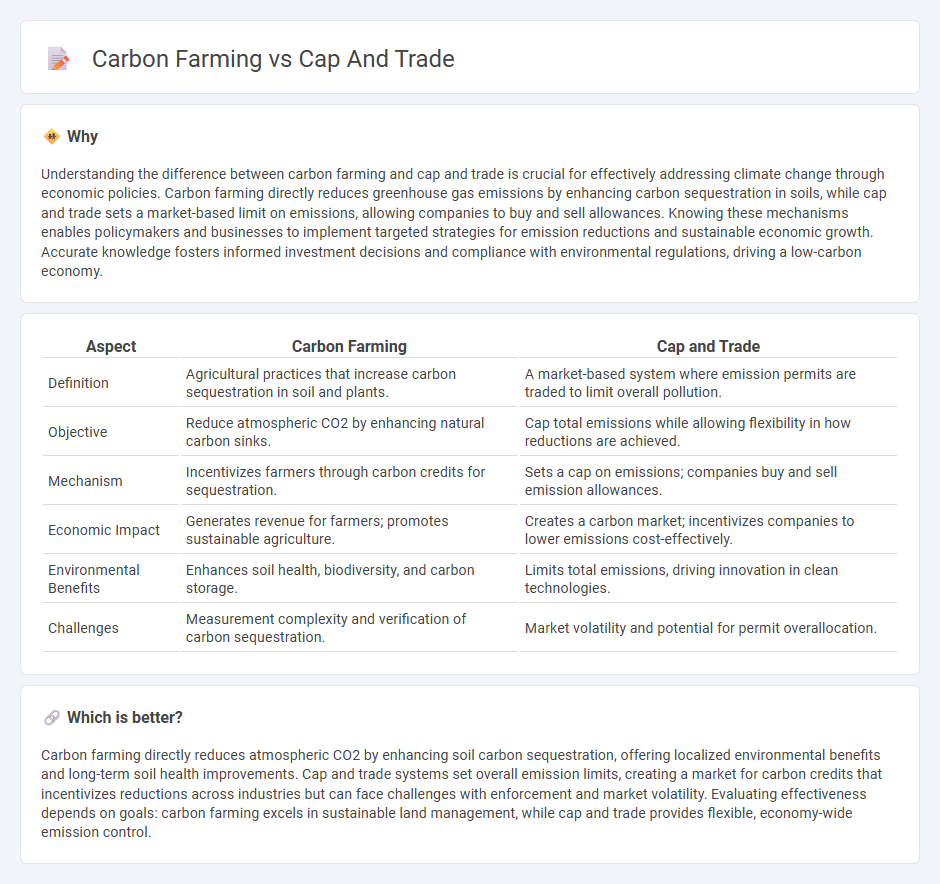
Carbon farming involves agricultural practices that capture and store carbon dioxide in soil to mitigate climate change, promoting sustainable land use and reducing greenhouse gas emissions. Cap and trade is a market-based approach where a government sets an emissions limit and allows companies to buy and sell allowances, incentivizing reductions in pollution cost-effectively. Explore the economic impacts and environmental benefits of carbon farming versus cap and trade to understand their roles in climate policy.
Why it is important
Understanding the difference between carbon farming and cap and trade is crucial for effectively addressing climate change through economic policies. Carbon farming directly reduces greenhouse gas emissions by enhancing carbon sequestration in soils, while cap and trade sets a market-based limit on emissions, allowing companies to buy and sell allowances. Knowing these mechanisms enables policymakers and businesses to implement targeted strategies for emission reductions and sustainable economic growth. Accurate knowledge fosters informed investment decisions and compliance with environmental regulations, driving a low-carbon economy.
Comparison Table
| Aspect | Carbon Farming | Cap and Trade |
|---|---|---|
| Definition | Agricultural practices that increase carbon sequestration in soil and plants. | A market-based system where emission permits are traded to limit overall pollution. |
| Objective | Reduce atmospheric CO2 by enhancing natural carbon sinks. | Cap total emissions while allowing flexibility in how reductions are achieved. |
| Mechanism | Incentivizes farmers through carbon credits for sequestration. | Sets a cap on emissions; companies buy and sell emission allowances. |
| Economic Impact | Generates revenue for farmers; promotes sustainable agriculture. | Creates a carbon market; incentivizes companies to lower emissions cost-effectively. |
| Environmental Benefits | Enhances soil health, biodiversity, and carbon storage. | Limits total emissions, driving innovation in clean technologies. |
| Challenges | Measurement complexity and verification of carbon sequestration. | Market volatility and potential for permit overallocation. |
Which is better?
Carbon farming directly reduces atmospheric CO2 by enhancing soil carbon sequestration, offering localized environmental benefits and long-term soil health improvements. Cap and trade systems set overall emission limits, creating a market for carbon credits that incentivizes reductions across industries but can face challenges with enforcement and market volatility. Evaluating effectiveness depends on goals: carbon farming excels in sustainable land management, while cap and trade provides flexible, economy-wide emission control.
Connection
Carbon farming enhances soil carbon sequestration, reducing greenhouse gas emissions and generating carbon credits. These credits are integral to cap and trade systems, allowing businesses to buy and sell allowances that meet regulatory emission caps. The synergy between carbon farming and cap and trade drives sustainable agriculture while promoting carbon market efficiency.
Key Terms
Emissions Allowances
Emissions allowances in cap and trade are government-issued permits that limit the total amount of greenhouse gases a company can emit, incentivizing reductions through market trading. Carbon farming, in contrast, focuses on sequestering carbon dioxide via agricultural practices that enhance soil carbon storage, creating carbon credits rather than allowances. Discover how these mechanisms uniquely impact carbon markets and environmental policies.
Carbon Sequestration
Cap and trade systems regulate carbon emissions by setting a maximum allowable limit and enabling companies to buy and sell emission permits, promoting market-driven reductions. Carbon farming enhances carbon sequestration by adopting agricultural practices that capture and store atmospheric CO2 in soil and vegetation, directly increasing carbon sinks. Explore detailed comparisons between market mechanisms and sustainable land management to understand their roles in combating climate change.
Offset Credits
Cap and trade systems set a maximum limit on greenhouse gas emissions, allowing companies to buy and sell emission allowances to meet targets efficiently. Carbon farming generates offset credits by enhancing carbon sequestration through agricultural practices such as cover cropping, agroforestry, and soil enrichment. Explore how offset credits bridge these approaches to foster sustainable environmental and economic benefits.
Source and External Links
Cap and Trade Basics - C2ES - Cap and trade is a market-based system where a government sets an emissions cap and issues permits to emitters, who can buy and sell these allowances, creating a carbon price that drives emissions reductions efficiently.
How cap and trade works - Environmental Defense Fund - Cap and trade works by setting a pollution limit split into allowances that companies must hold for their emissions, allowing trading to incentivize earlier and cheaper pollution cuts.
Cap-and-trade programme | UNFCCC - An Emission Trading System (ETS) imposes a cap on greenhouse gas emissions and enables entities to buy and sell emission units, balancing supply and demand to regulate carbon pricing.
 dowidth.com
dowidth.com